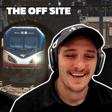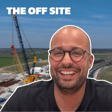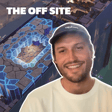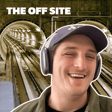Become a Creator today!Start creating today - Share your story with the world!
Start for free
00:00:00
00:00:01

How Reality Capture is Revolutionising Construction
This week, Jason and Carlos get to grips with reality capture and it's emergence in construction. To do this they've enlisted the expertise of Marco Bonelli, VP of Innovation at Sektor.build.
Together they define reality capture's place in construction, talk who the big players in the space are, and establish how useful it is for infrastructure projects.
Follow Carlos on Linkedin | Follow Jason on Linkedin | Check out Aphex
Transcript
Personal News and Podcast Introduction
00:00:00
Speaker
So, currently, my wife is pregnant. We're expecting twins. They're going to be expecting in October. So, congratulations. That's going to be like a call of baby moon to just go away two weeks before the world will change. yeah okay Yeah, okay. Very good. At the house I'm in now, we're with our friends who have four-year-old twin girls. So, yeah, twins are interesting. Yeah, kids everywhere then. Are they your first? Yes, the first. So, life is about to change. Yeah, yeah. Boys or girls marker. Two boys. Amazing. so I don't know if that would make it harder to do name selection or easier. um You know, easier because you don't have to choose between the final two names. ah
00:00:45
Speaker
it
00:00:48
Speaker
You're listening to the Offsite Podcast with Jason and Carlos, where we talk all things construction and technology. Join us for discussions with industry leaders and insights into the latest trends in construction.
00:01:02
Speaker
Welcome back to the Offsite Podcast. Jason, how are you doing? I'm very good, Carlos. How are you? I'm all good, thanks. I'm in a bit of a different setting today, a way down in France, but the sound's into that and everything seems to be okay, much better than what yeah you have. Yeah, you look relaxed and decompressed, so it must be doing something, you must be doing something right. i I had the and the pleasure, well, I was reflecting before I dialed into this call about how different this week and next week might be for me. I've just flown back in from Melbourne after traveling down there for a day and last night got to go out to quite a nice dinner with some folks I used to work with about 10 or so years ago. so Oh wow. Got to have some, a nice meal, something to drink, ah relaxing, chatting, talking about old war stories. and And this time next week, I'm likely to be elbow deep in shit filled nappies.
00:02:00
Speaker
well yeah Yeah, and takeaways. I was going to say delivery, but it's a door dash you have over there. That'll be it. Yeah, it's on me. I don't know. Whatever the baby eats. Yeah, yeah. So you've dusted off the old nappy beard and everything and got it all. You're ready to run. I don't know if you've ever seen the used nappy bin before, but I don't think dusting it off is um is going to suffice. freshize I've pressure washed it. Yeah, yeah. yeah Yeah, some nuclear cleaning ah equipment is what we've done. Yeah, a bit of bleach. We're good. Yeah, exactly. Good stuff.
Introduction to RealityCapture with Marco Benelli
00:02:37
Speaker
Yeah, and we're going to have Mike back filling in for an episode or two while you're gone. So um yeah, I'm sure he's excited to come up.
00:02:44
Speaker
Well, he can take it. It's all his. Good stuff. So um today we're going to be digging into the world of reality capture on construction sites. We're going to explore how these tools sort of claim to enhance accuracy and detail of site documentation, improve communication among stakeholders, save time, reduce costs, enable precise progress tracking, a nice wish list of ah ah benefits from these sorts of tools. We'll also sort of cover some maybe some of the tools that are leading the way in in the market. um And to help us shed some light on this, we are thrilled to have Marco Benelli.
00:03:19
Speaker
um join us on the podcast. He is currently the VP of Digital Delivery at SectorBuild. They are a sort of a deployment partner who help contractors bring on and embed technology such as reality capture. ah Mark can probably explain that one a bit better than I have. Mark was also previously BIM and technology lead at contractors like Binchy and Sysk. He has real-world experience of how ah tools are actually embedded and used within these organizations. So, Marko, welcome to the podcast. Oh, thank you, Carlos. Thank you, Jason, for having me. Please, I'd love to be here. Thanks for the great introduction.
00:03:58
Speaker
i'm I'm very excited to talk about this topic. It's something that I i talk about in internal meetings every week, because I'm i'm just genuinely interested from a technological perspective. so And then the people, when I talk about it in internal meetings, we don't have really any idea in the in the detail and in practice, so I'm i'm excited to to learn and discuss it. ah Here we go. It's another tool to me, and QS's don't have to go on site, so I'm sure they'll be interested to hear this. Anything to get rid of QS is right up my alley. Yeah, yeah. to was said So, Marco, our audience like is typically engineers, planners, project managers, construction leads on projects. um I'm sure a lot of them have never used RealityCapture tools. So, in a nutshell, what is RealityCapture? Yeah, of course. So, RealityCapture is one of the most hot
00:04:46
Speaker
technology currently across ah contact, probably with the start of a pandemic. And I will define the right to capture a system that will enable remote and photographic digital photographic record of the construction site. So if we want to add very simple, we can go after deep, but in a simple word, enable a label ah digital structure photographic record. as an equivalent of Google Street View, if we want to say, for our construction site, enabling remote site visit, allowing people that are not on site to reduce travel to
Potential and Current Applications of RealityCapture
00:05:18
Speaker
site. We can watch on the laptop. ah You mentioned about QS going on site, so they can use the system to view the verification of some part of the site, also planning team helping them to view certain parts of the site. And I must say, after AI, but not the biggest AI in construction today,
00:05:34
Speaker
It's one of those hostess topics ah about contact ah across all the all the industry. Yeah. Okay. Yeah. So it's the it's the ultimate view. What is site right now? Let's have a look at it. As you say, Google street map, you can go on, you can navigate and you can see what the story is at that point. As with any sort of new technology, there's this sort of curve of the technology advancing and people started to use it. What's the ultimate endgame? Like, what's the big vision of RealityCapture? Where do you think it will we we'll go? Well, I would say that there are different ways that RealityCapture can be used, from the simple one where we can have a simple progress recording, so replacing the manual photographic evidence that everyone working on site, everyone that's been on site goes around with the phone and taking pictures. So that can be the basic
00:06:20
Speaker
output and the most simple one of going very deep where AI, we can leverage AI to automate the construction progress and tracking percentage of completion. So the machine learning and AI can tell wherever a certain parts of the building as X percentage of completion and compare with the baseline program. So I help the planners of monitoring the building, understanding, providing early warnings and take a specific action to avoid delays on the construction side. So I believe that would be a kind of ultimate ah use of how the AI can help, but also announce inspection. So one of the biggest questions that we've always been asked by clients is, when we take this picture, can now AI start to identify issues? Instead to be a manually, a construction manager identifies not to open observation. Can AI identify
00:07:12
Speaker
issue on those pictures. I believe that is not there yet, but as an ultimate goal, that would definitely help the site team to automate inspection and be able to just get quite a better quality, a better outlook for a construction site. The first part of that, you mentioned obviously the progress updates, which we can potentially use for the planning and commercial side of things. Is that actually used now? So like, would we take a percentage complete and apply it to like a master schedule? Or would we take a measure of progress and use it for a payment schedule? Or is it more of an indication to give you a ah gut feel whether your own assessment is correct?
00:07:50
Speaker
Of course, there is there are some technologies that give you a progress in percentage of the current program. So the key elements with having a very good three models, these are three models, so the AI machine can gather all the quantities needed. But for the next step, about payment practice, about fully updating your construction program, the other in ASTA or Prima Meta P6, of course, the manual intervention of the planner is fundamental. And what is need to be wrapped around is the right process. We have seen many cases where the planner or the construction team didn't really trust the information coming from ah the tool, and I believe that is a key fundamental aspect. If there is no process, an adoption process behind, whoever is going to use this new technology is not going to trust it, and still going to go on site and double check if the information provided by AI is
Workflow and Integration Challenges
00:08:42
Speaker
correct.
00:08:42
Speaker
And of course, the ultimate goal for this technology is not they want to replace the user, but they want to make them save time, be able to update the progress, and then ah check on the construction program, find some issues, and then work with the QS for payment practice. And if the QS receive an invoice for, I don't know, boot doors that have been installed, doesn't have to go on site, can simply check. in a few seconds if those information are fully complete and then process and the payment, processing void. So I can see this system providing a grant aid for normal rules and they can just find, limit the time in admin. So the goal is limited the admin time. So they can be focused on high value activities. So automate certain tasks that normally take a lot of time and they just add new work.
00:09:31
Speaker
um' I'm going to warn about going straight into the weeds with my first question, ah Marco, but this area is like really interesting to me. So the idea of being able to automatically report back on a percentage complete on an activity from ah from a schedule. So you talked about the the need for a detailed 3D model. That requires obviously some awareness of the types of meanings of the things that are in the schedule, the relationship of those things in the schedule to the model, and then the ability for the image or the the photography to understand that it is that image and is that element in the schedule.
00:10:09
Speaker
What is the like best practice workflow that you've seen ah in terms of how that kind of report of percentage complete makes its way back to the schedule? Is it something that's getting populated ah into a property in a schedule that someone's reviewing, or is it something that is supposed to go into another tool? What's the sort of workflow look like to make that of course thing become a reality? So I've seen different cases. Of course, ah the the control of the planner must always be ensured. So no construction site will ever have a full work if the planner doesn't fully control the program when we update the baseline against the construction actual program.
00:10:50
Speaker
So the way that we are normally seeing is adding a structural process behind of day one on, you know that you're going to use this type of technology. So the full three model developing the certain way to ensure that key elements are available. And the rest is kind of taken by the AI technology. So the beauty of the system is there is no much moral intervention from the construction team to be able to set up the model against the progress. That is the AI machine learning technology that get the job. behind, you only get the percentage because then for mental models, you get the percentage of the quantity of plaster wool and from the ah machine learning, you get the percentage completion of what is today. Of course, the key element is what do you do then? You get some information on the reality capture ah platform and the key is how this information will get feedback to your master program.
00:11:42
Speaker
ah As a best practice, I feel that there always must be a control. So once you receive the information from the right to capture the plan that goes and update the planner, I feel that an automatic update without the control will slip something away. So we've seen cases where the planner still wants to have to screen, you get an output and the output that you get your manually encoded percentage on the right to capture, also on the planning program. But that gives you a double entry of data. Obviously, in case where there is a full control, where you have a full update, where the planner has to update or reject the entry. So if you see that all first floor are complete 50%, you do ah your review and you're happy with the data and you click Upset, then you can go automatically update the percentage of your master cell. So that still gives you the control and the feeling that the planner always has everything in control and nothing can slip away.
00:12:38
Speaker
That acceptance workflow, that's something that sits outside of the schedule in the reality capture, or are you building a layer in between the two things ah for that acceptance? There are different technologies that can help in that case. Each technology is different. And of course, some someone with Pethic, someone who uses a hardware project or Microsoft of plan depends on your technology. There have been some integration cases we have seen, more of Bespoke, where the data can flow from left to right. But ah normally when there is no direct integration, we see an output from the relative capture and then a manual update.
Daily Use and Long-term Benefits of RealityCapture
00:13:16
Speaker
manually yeah brother yeah But also we have seen cases where the information kept on the relative capture because it imports the master schedule as being used as a unique source of truth. So it's going to be used that one to keep the information not going back to other P6 or other planning. Yeah, right.
00:13:34
Speaker
Okay. And the more advanced team. All right, so the more advanced team where the planner and the planning team is more advanced in technology, we have seen that is a good case where they don't use any more of the PCs as a day-to-day system update program. Yeah, okay. And then obviously when it comes to AI interpreting progress on site, there's probably certain things that are a lot easier to interpret than other things. So whether a door's installed or whether plaster's installed is probably, um ah easier to measure and then things like whether the cables installed. or so what are the what are the sorts of things that ah yeah What are the sorts of things that it's good at and sorts of things that it's not good at the moment in terms of measuring? name As you mentioned, they can be very small bespoke element than maybe the first time they got installed and the machine learning doesn't really understand what they are. but Of course, for general elements like structure, cluster boards, wall ceiling,
00:14:28
Speaker
ah general MAP equipment like ventilation ducts, air handling unit, windows, door. So those elements are really good. Initial electrical parts, so plugs, light switches, lighting fixture. So those one, the system is really good ah across different vendors ah to identify because there's a big set of data or recognizing the filament. Of course, if you go on a bespoke project, there could be something about a data center or can be about or delivery of certain specific buildings and this spoke element is not very common, there is less data set. That is where the system can keep some gray area, but the system will align that is not 100% secure about the element. So then there's going to be and
00:15:16
Speaker
is the wide the use of the planner and the interventions from the mentor as a gatekeeper to understand and not fly blindly the information coming from the eye. Yeah, yeah. And then I think ah most people that are familiar with the space would have heard of companies like OpenSpace. Who are the other leaders? like I know DroneDeploy has both the drone and the sort of walk around with the the the camera. What are the what are the platforms that ah you're seeing broadest the adoption of? So yes, OpenSpace is one of the, probably the biggest one in the space, probably the first one that started. You mentioned drone deployed that acquired a structural site in 22, I believe. That's seen build-outs, I've seen dispersed, Cupix, those are reconstruct, those are biggest platform across the area for 360, Oculo, very focused on UK market. So I would say those are the top player currently in the market.
00:16:16
Speaker
And what separates like the the best from, from I guess, the the rest of the pack is is the thing like the the ease of use of the platform or is it the thing like the the AI capabilities? what are the sort of What's the big difference between, say, the leaders and the the middle of the pack? I will now say that what is the best and what is the worst in between all of them. The key element is understanding which is the required outcome. So when you implement a write-a-capture, you could just implement it for progress recording. So it's in case where a general contractor wanted to replace the manner photo, taking one side team and just using a more dynamic solution.
00:16:55
Speaker
or use progress structure, what we just talked about, update construction program. We can use it for enhanced inspection. So, it depends which is your target. Each of them has a specific sweet spot. Let's call it to use the chronology. So, the key element is making it understand which is the key target, the why you want to implement ready capture. How difficult is it to implement? So my oversimplified dumb brain, he's not very technical. Do you upload a model, grab the handheld stick and start lapping sites each day so it captures the image? Or is it quite a implementation piece that comes with this?
00:17:32
Speaker
So then the-to-day use of the platform is as simple as you describe. So you up apply you upload a 3D model or a 2D plan to DJ plan, you grab the camera, ah make a click on your phone and start recording. So the system, all the system mentioned before, they use a SLAM technology. That's the same one that Tesla use for the self-driving cars. So they recognize objects and then match the object against objects in the tree model or on the plan. So column with the column. So they generally differentiate new GPS and be able to map.
00:18:03
Speaker
against the plan. The other part about adoption is what do you do with information? Because just simply capturing the site, that doesn't mean that the system gets adopted. this What do you do? How do you consume the data that gets provided? and Based on your initial target, there are different tasks. For example, there can be cases where it can be used to defend yourself against claims because you have a full photographic record about the information. so If just the site team goes around and capture the site, but no one ever viewed the information, there is not really a good adoption. So it's simple on site, but the most important part is understanding how this will fit within your current process. Can you update progress or can you have an inspection, for example, with quality check form, and you can do all your capturing you can do after and then start the collaboration process that normally happens. So I would say,
00:19:01
Speaker
ah For the day-to-day, it's very simple, but the biggest part is making sure that it's fully adopted across the standard process of construction companyial acidce on it yeah so the We were talking right at the start. Carlos talked about the like what's the big vision of of what you could do once teams are starting to capture that data and there's more and more i guess integration and ah maybe the ability for AI to to extract sort of structured data from there. There's obviously, I've seen a lot of conversation around things like, obviously, instead of people doing the laps at the site, robots and drones and those sorts of things I've seen. ah there was I think there was an announcement recently where Shepherd, the insurance startup from the UK, was offering some sort of ah discount arrangement with OpenSpace on the ah the the level of adoption of capture there. of their platform in terms of capturing site. what's What else is kind of um out there in terms of um long tail value for the for the people that are adopting and implementing reality capture on their on their projects?
00:20:06
Speaker
so um but I really like the part about the insurance that you mentioned in US. There was an article probably written a few days ago where a nu insurance provider of investment with open space, more user technology, more discount you can get on your premium insurance. And that was an amazing part, currently only seeing US and not across the rest of Europe. And also you got seen about adoption, more if adopted, more percent of the discount. I will say as a long term, one of the key element is about having
00:20:37
Speaker
a full record of what has been built. As you know, a structural account for 30% about rewards and mistakes. By having a structural record, that you can go back in time on what has been built. It gives you the strength and the flexibility to understand if something has been done well or something has been not built correctly. So they can be either defend yourself from a claim or if you have a leakage on the ceiling, before even going and breaking everything down you can go and check what has been built so you can have a better idea and you can target get the part that you can break the ceiling instead of just break everything up so that helps in the long term but also consider especially UK when we have the golden thread especially on the fire information having a structured photographic report.
00:21:20
Speaker
I feel and I strongly believe that nothing ah other than the right of caption can provide the digital structure, photographic evidence of what has been built. So helping on the golden thread and especially on not on the design part, but on the build part, making sure that what has been built is up to specifications have been checked. But I'm assuming that typically the customer of these tools is the contractor or the general contractor. Have you seen examples of, say, the client mandating these tools so they can use the data to ah check the records of the contractor or even do things like, as you said with AI on imagery, check the safety of the contractor things on site? Or is it is it all sort of contractor-led at the moment?
00:22:00
Speaker
um Definitely, the big hype starts with general contractors, probably at the time of pandemic when remote visit it was a must and with odd limitation of social distancing, we could have not gone inside. But now, yeah we have seen cases where asset owner has mandated the use of general contractor or asset owner worked with PMO or client representative, so they have their team, in terms of client representative, capturing the site to have a better understanding of what's happened, so checking with the contractor, overall understanding how their money has been spent and be able to have a better output in terms of collaboration. Another part that also been seen from the asset owner is they're going to be the one managing ah the building for the next 20, 30 years. So having a photograph photographic record of what has been given and how can be updated in the future is definitely a high point. We have seen case where a high developer that works with offices
00:23:00
Speaker
Mandate the use of relative capture since they want of construction and because their office it cannot be changed probably 30 times during the next 20 years and the tenant comes, they update the the office.
AI Integration and Future Prospects
00:23:11
Speaker
Having this digital record every time what has been updated, what was before and adding an endeavor when is given to the new client, and when the tenant left having another photographic record, it's becoming fundamental for the use of the asset owners. Also linking ah asset information, because you can now link, I don't know, another manual in terms of link with your righty capture becoming more dynamic. So yes, starting with your contractor with the eye, but now ah about the subcontractor PMO and asset owners, everyone tried to use this technology.
00:23:44
Speaker
I can vouch for that. i Having renovated this house that I'm in right now, I can't tell you the amount of times that we've gone to put a hole in a wall somewhere and had to hunt through mountains and mountains and mountains of photos trying to work out what was behind the wall. If only we'd done the yeah reality capture at the time. Yeah, for sure. I've done the same. Yeah, I used when before I had that account for dramatic capture and the roommate in my house, so we almost tear it down, almost everything. And I used one of the 60 camera and I went around doing some capturing and the local contractor was looking at it. Why are you capturing? Looking like an alien with the camera on my helmet. Yeah. But it definitely helped. I didn't control the sight. Oh.
00:24:26
Speaker
For sure. i could spend We spend sometimes have to spend an hour trying to find this photo of a wall at a certain stage and then realize we took photos both sides of it and not the spot that we actually need. um it' If I'm a local house builder and the customer starts doing reality capture, I'd probably be quite scared. yeah very good say that particular yeah the episode Marco, do you see um do you see that if you take this idea of the the reality capture as a source of record of the site, ah whether it eventually replaces or eats or maybe even supplements like a site diary for a contractor?
00:25:07
Speaker
I've seen the benefit in certain parts, especially with more AI coming through and more information adding the supplement. Of course, not replacing it, but aiding the population of the filling out of the site diary can definitely help. Certain information about which activities has been taken today. If you have been around with your cameras and you have been recording the site, those can be certain information that can be linked limiting the manual input and the admin time that we need. The side team that is overloaded about work needed to do. So definitely I see a great aid on the side diary to be able to be reduced on the admin time and BCI to fill out some information.
00:25:50
Speaker
And so how much of that kind of integration are you kind of seeing, or do you think that is happening at the moment? We've talked about the idea of of of maybe to P6 or Asta, but sometimes it's kind of a manual update. um what What is the extent, and you know maybe you could have that coming across to a a site dive platform. What's the extent of integration kind of happening at the moment, and is there still a long way to go with the depth of integration? There is still some work to do, but I'll be the biggest platform that really integrate. Well, we try to capture other croc or, or office constructions cloud. So they have a big integration with some of the big player mentioned before, in terms of writing capture. And day by day, this type of integration is becoming bigger. So currently you can all view the capture within your, uh,
00:26:38
Speaker
system for example, all links, nugs, observations. So you reduce the double handling of information. So you start from your ready to capture and you move them in your normal ah quality control process. But we, as soon as we try to bring about link-on-site diary, we see that the biggest opportunities with the PNCs or PMIS, like proper Autodesk or other solution, ICONX in terms of connecting with that. Because with many clients that we work today, one of the biggest questions we ask is, okay, we are using this technology, but how do we link the observation that we are taking through a PMI solution? and I see the biggest opportunity and the biggest time setting and efficiency improvement connecting ah these two other than with the planning solution when we do tracking monitoring.
00:27:25
Speaker
and so the yeah I could definitely see the snagging and observations for sure being done. You do that natively in the RealityCapture product and then that's populating over to Autodesk or Procore. What other things you can you do natively that then or would you see people doing that populates over to um other platforms? ah That is a very good question. The part that I would love to see where technology now expands every day with the use of AI is the auto-tasking of defect and be able to generate defect. It's normally
00:28:03
Speaker
The technology is there, but the 360 picture, as you know, is a spherical image. It's not like a standard picture. So the see the picture gets the form, so the AI needs more time to identify the fact. And also, construction is so bespoke. that doesn't really, there is not a defect, it's always the same, up and in different phase. And also has to be related to the timing of the construction program. If you work today around the site and the ceiling does not being closed, it's not because of the defect, because tomorrow maybe the anti-contractor is coming to finish something and after the ceiling is closed. So having also the relationship with the with the construction program is a fundamental part to get false positive.
00:28:44
Speaker
So the part that really I would love to see is the integration and why much deeper integration with AI quality control and the construction program to be able to identify a defect automatically. And that is a real defect. It's not something that has been left and complete on purpose because it has to be complete in a few weeks time. Yeah, so so in other words, the ability to go, right, that that thing in the schedule has been marked as complete, but we're flagging that it's not complete, which I imagine is quite a difficult thing because there could easily be another activity in the schedule representing the finishing of it somewhere. and yes it's I can imagine you get false positive all over the shop. Yeah, so I believe that linking the quality control is with the tracking program is one of the key elements that can definitely help our industry to build better. So ah not manually go and check for defect by having a system to help you bring in defect to you and be speed up with the resolution of all the issues.
00:29:40
Speaker
What about the the types of projects that are and contractors that are adopting it more assertively than others? I think a lot of the examples that I've seen around tend to be building contractors or large commercial contractors. um are you seeing ah Do you see it happening much in infrastructure or um and and and what's the overlap with drones? Yes, that is the other part. in Infrastructure, initially there was a doubt if this technology could have worked in infrastructure. It definitely worked. We have seen cases where 360 camera are mounted on top of the car and with a very slow drive around three, four miles an hour, capturing miles and miles for linear project. And we have seen that and it worked amazingly. We were surprised. But then you have the overlap with the drone.
00:30:27
Speaker
So where is useful for? So I feel that the use of drone in terms of photogrammetry is really useful for cutting field, like getting certain digital information to create a digital 3D model output from your capture. Something that on the 360 capture, you are not creating this kind of digital twin, it doesn't generate a model. So it's not a photogrammetry. So I see an overlap depends of what the general contractor or the project wants to track. So if they're more interesting about the cutting and field and generating a 3D model from the photogrammetry, definitely the drone is the right way to use it. But also we have case where maybe close to an airport or certain limitations the use of a drone is very hard ah to have. So yeah, going back to a reality capture, adding the camera on top of the car and slowly driving on a side, it definitely helped. We have seen case where adding on top of the bike,
00:31:20
Speaker
because it was not as wide as I decide to use a car, but the end of the bike, the end of the element, on the car. We have seen many cases where the use of light to capture them 360 cameras has been pushed boundary in many different cases. Yeah, right. i cause i see i think What I see from most infrastructure projects is is ah like they're definitely using things like a propeller, and the the the engineers are in propeller every every single day doing stuff. And then they're all putting up cameras across the site in kind of static camera positions and and documenting there. And whenever I go and meet someone or go to dinner, every five minutes through the the dinner, they're looking at the cameras across the site to see what's happening.
00:32:00
Speaker
um ah in terms of Yeah, you can think I think of a lot of projects like ah a road or a rail project, there might be one section of the project that benefits from kind of like the drone type capture, but then you have a bridge or something where the the handheld is more appropriate. And ah other than drone deploy, do all which of the products have the ability to kind of do both? And do people have an issue with using two different platforms to do the reality capture? So in terms of the doing both solutions, drone deploy, I only believe, is one of the only ones that can do both. Because all the other 360 solutions that we mentioned before, they are fully focused on 360 cameras. We have cases that now there are
00:32:44
Speaker
There is a 360 camera dedicated for a DJI drone, so you can mount a 360 camera on a drone and use it on the same platform that you're currently ah using the normal auto space or being the normal head platform. Set to be handheld, you put on a drone and basically replace instead of working, you put on a drone, but doesn't give you the possibility to do cut and fill and create a digital model. and the photogrammetry. It's just a different mean, a different way to capture. In terms of adding both, a full photogrammetry from the drones and the 360 I currently see, don't deploy to be the top of the market in that solution. And I also want to add, depends which is the the target. I'm very big fan of static camera when, for example, there's a very low field view and something that has to be checked.
00:33:33
Speaker
But if you need to check something very in detail, very hard with a static camera, you will be able to go in detail, zoom in something that is a kilometer far. And I always say that we have so many people working around sites for many different reasons. Just grabbing a camera and adding on top of your helmet, it doesn't give you an additional task. You just basically add the camera and and do your day-to-day work. It's not an additional task that should be taken to record the site. That is where I see the opportunity where there are so many people just grab the camera and work on the side walk around Walk around, yeah. Do you see that the direction of travel is that, the and this is, sorry Carlos, this has been my last question. Do you see that the direction of the travel, Marco, is that platforms do this kind of consolidation where
00:34:17
Speaker
that they start competing on the ability to be the the all-in-one reality capture? Or do you think that that's not as important as as getting good ah handheld AI schedule update integration? Yeah, where do you see the value being added? A platform in general, I'm not just talking about a system that wants to do everything. is going to start losing quality in other parts. So I think that if you have a very good core capability in one part and you try to become capable of trade, whatever you're going to have, it's not going to be your core capability. It's not going to be as good as the other part. So I feel that more integration between different technology will be more useful to use the core capability of each of them to be able to integrate technology in a much easier way rather than becoming a technology that does everything.
00:35:07
Speaker
Many of the clones have tried in general and not everyone has been successful. So I feel that there is that risk of technology to do everything and they become probably worse in the core product to try to build more resources in terms of development team in the other part. So I feel more about collaboration across different technology integration would be the right team. Yeah, I agree. I think that's ah ah that's the right way to think about it. i'm Sorry, Carlos, you had a question. Yeah, sorry. Looping back to the the conversation just before, I was in the part of a call the other day where the team were discussing how they were going to capture image on a particular site. And they were going for the sort of static camera option. And they immediately had the issue that you just said, which is the range of vision and how accurate it is at distance. Has anyone attached
00:35:52
Speaker
is Are the drones just doing like a daily fly-by? Or do they can you now have them like hover oversight to give the live feed like the cameras do? so I don't feel that that's rights that's that's a corny surveyor question, that is. I didn't ask the question at the time, but I sat there thinking, that's a really good idea. Is that not possible? is it i they've got like They've got like a two hour two-hour battery life or something on their cars. Other than the battery or flying drones, it become recently very straight internal regulation. So you have many tools that do the self piloting, so you don't pilot yourself, you just set up the path and the drone. But the pilot always need to be present to oversee in the process. So you're going to have a person just looking all day, the drone.
00:36:41
Speaker
So I would not go in that direction. I would probably look at different technologies ah what the or more cameras in different angles or go on a 360 solution. Okay. Jason, I won't join the product team then. ah maybe in my hard days yeah I've definitely got some cameras to sell you if you're buying Carlos. I might prove it first. Right. That is definitely all we have time for today. Marco, thank you very much for joining us today. That was a really good conversation. Yeah, that was a very good conversation. Thank you, Marco. Thank you, guys. Really love the talk with you. Thanks. And thank you very much everyone for listening. We are trying to pull information from any listeners at the moment in terms of what episodes or discussions you'd like us to have in the future. So please do feed that back. It does help inform what our roadmap of episodes looks like. What do you have to say? Link in the show notes, Carlos, to a service.
00:37:40
Speaker
Yeah, yeah, Ollie's gonna have a go at me now. There is a link in the show notes, but please do pass back your feedback. um We really do appreciate it. Thank you very much. Thank you. Thank you.



















